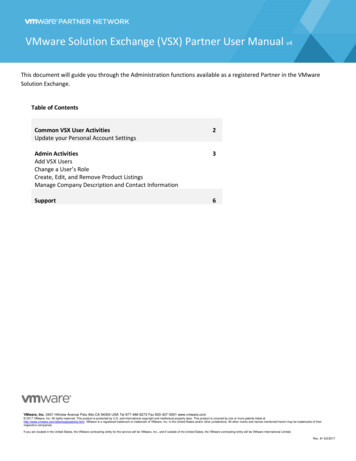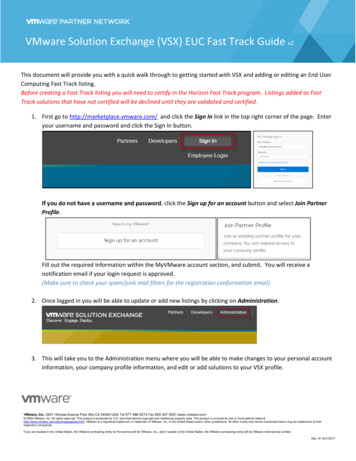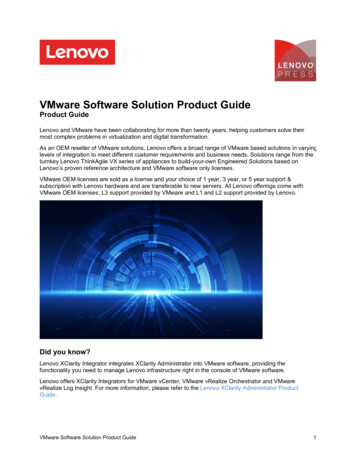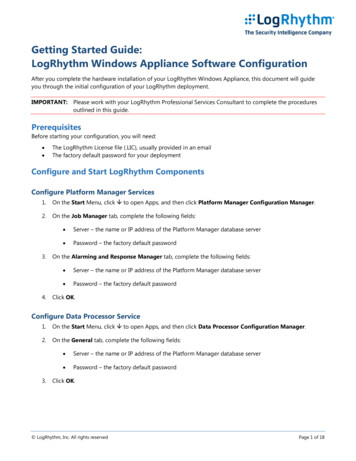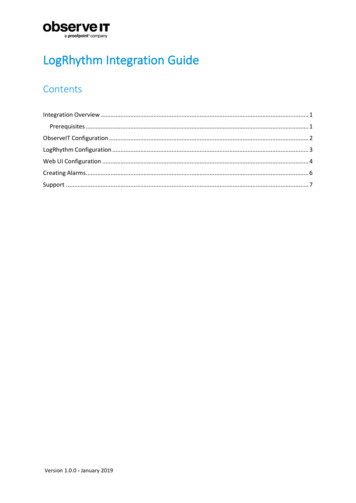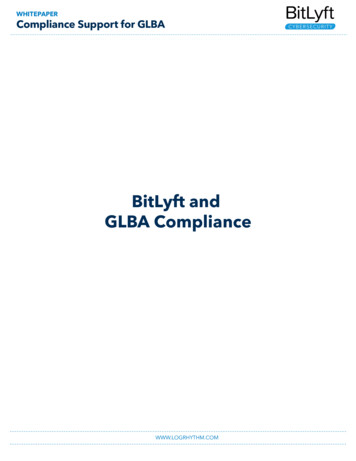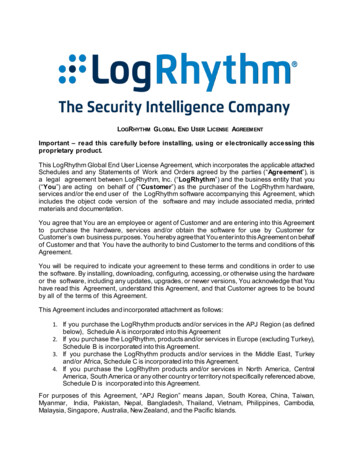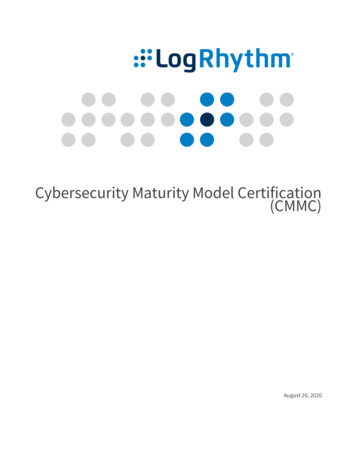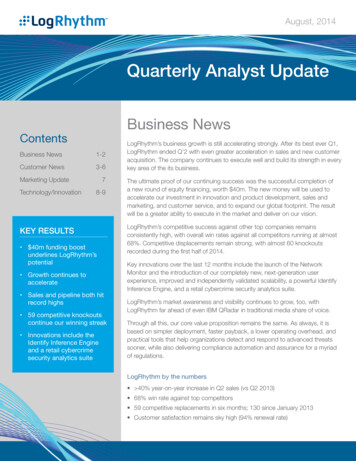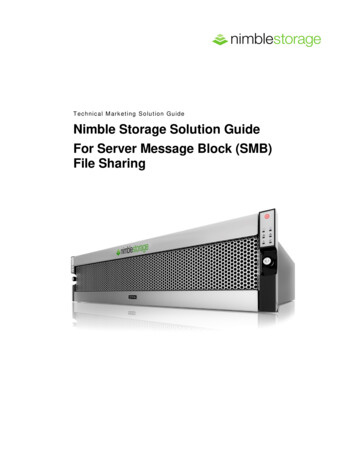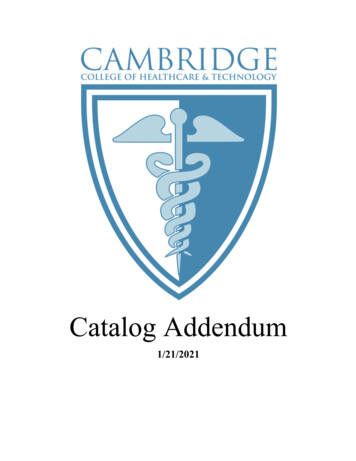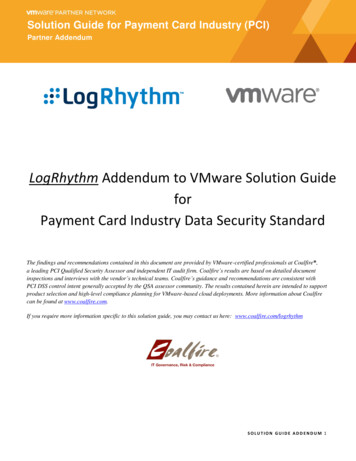
Transcription
Solution Guide for Payment Card Industry (PCI)Partner AddendumLogRhythm Addendum to VMware Solution GuideforPayment Card Industry Data Security StandardThe findings and recommendations contained in this document are provided by VMware-certified professionals at Coalfire ,a leading PCI Qualified Security Assessor and independent IT audit firm. Coalfire’s results are based on detailed documentinspections and interviews with the vendor’s technical teams. Coalfire’s guidance and recommendations are consistent withPCI DSS control intent generally accepted by the QSA assessor community. The results contained herein are intended to supportproduct selection and high-level compliance planning for VMware-based cloud deployments. More information about Coalfirecan be found at www.coalfire.com.If you require more information specific to this solution guide, you may contact us here: www.coalfire.com/logrhythmSOLUTION GUIDE ADD ENDUM 1
Solution Guide for Payment Card Industry (PCI)Table of Contents1.INTRODUCTION . 32.CLOUD COMPUTING . 73.OVERVIEW OF PCI AS IT APPLIES TO CLOUD/VIRTUAL ENVIRONMENTS .114.LOGRHYTHM PCI COMPLIANCE SOLUTION .145.LOGRHYTHM PCI REQUIREMENTS MATRIX (OVERVIEW) .15SOLUTION GUIDE ADD ENDUM 2
Solution Guide for Payment Card Industry (PCI)1.IntroductionMerchants and service providers that transmit, store or process payment card information are required to meet allPCI DSS controls in order to fulfill the compliance standard for accepting payment cards. LogRhythm is working withVMware to provide solutions that help customers achieve PCI compliance through log and event management in virtual,physical and hybrid environments.Clear visibility into all aspects of an organization’s IT systems and user activity, whether that of employees, partners orcustomers, is imperative in today’s networked environments. IT administrators and security professionals are taskedwith monitoring and protecting an overwhelming number of transactions and events that traverse their systemsevery day.Having an effective log and event management solution to gain network visibility and better understand the overallhealth of a networked environment is not only a valued asset for IT professionals, it has become a requirement forregulatory compliance. When deploying a log and event management solution for compliance, organizations shouldensure that the information provided by event logging systems is meaningful and relevant and that its collection isconsistent and assured. This requires assuring that specific types of data are logged with a secure chain of custody sothat an effective audit trail can be constructed.LogRhythm delivers out-of-the-box packages for PCI compliance, either directly meeting or augmenting 80 individual PCImandates. This includes fully integrated File Integrity Monitoring that directly meets PCI DSS 11.5 – without requiring anadditional third-party platform. PCI compliance is helped by fully automated packages that include out-of-the-boxreports, investigations, alarms and layouts, directly mapped and clearly labeled to correspond to each supportedmandate. LogRhythm also has out-of-the-box support for point-of-sale systems, with advanced agent technology thatenables collecting from remote retail locations. Agents are centrally deployed and managed and can encrypt andcompress data for secure collection without negatively impacting bandwidth. If a connection is lost, the agent willcontinue to collect data at the remote location until communication is restored, to ensure that no data is lost.LogRhythm and VMware provide a framework that includes both LogRhythm and VMware systems, as well as otherpartner products, that enables customers to meet their PCI DSS control requirements. The appropriate integration withinfrastructure products provides customers with additional capabilities for successfully navigating the compliancelandscape. LogRhythm is architected to monitor components within a PCI environment, whether fully virtualized orleveraging a hybrid infrastructure of virtual and physical components, to detect and prevent confidential data leakagewithin the PCI path. This includes auditing user information and resource access, as well as independently monitoringvirtual and/or physical host activity and communication between internal and external components, including sharedvirtual resources.This paper examines the capabilities of the LogRhythm SIEM 2.0 platform in achieving Payment Card Industry (PCI) DataSecurity Standard (DSS) compliance, and describes how this solution aligns to PCI DSS controls.SOLUTION GUIDE ADD ENDUM 3
Solution Guide for Payment Card Industry (PCI)VMwareCompliance and security continue to be top concerns for organizations that plan to move their environment to cloudcomputing. VMware helps organizations address these challenges by providing bundled solutions (suites) that aredesigned for specific use cases. These use cases address questions like “How to be PCI compliant in a VMware PrivateCloud” by providing helpful information for VMware architects, the compliance community, and third parties.The PCI Private Cloud Use Case is comprised of four VMware Product Suites - vCloud, vCloud Networking and Security,vCenter Operations (vCOPs) and View. These product suites are described in detail in the VMware Solution Guide forPCI. The use case also provides readers with a mapping of the specific PCI controls to VMware’s product suite, partnersolutions, and organizations involved in PCI Private Clouds. While every cloud is unique, VMware and its partners canprovide a solution that addresses over 70% of the PCI DSS requirements.Figure 1: PCI RequirementsSOLUTION GUIDE ADD ENDUM 4
Solution Guide for Payment Card Industry (PCI)Figure 2: VMware LogRhythm Product Capabilities for a Trusted CloudSOLUTION GUIDE ADD ENDUM 5
Solution Guide for Payment Card Industry (PCI)Figure 3: Help Meet Customers’ Compliance Requirements to Migrate Business Critical Apps to a VMware vCloudSOLUTION GUIDE ADD ENDUM 6
Solution Guide for Payment Card Industry (PCI)2. Cloud ComputingCloud computing and virtualization have continued to grow significantly every year. There is a rush to move applicationsand even whole datacenters to the “cloud”, although few people can succinctly define the term “cloud computing.”There are a variety of different frameworks available to define the cloud, and their definitions are important as theyserve as the basis for making business, security, and audit determinations. VMware defines cloud or utility computingas the following ublic-cloud/faqs.html):“Cloud computing is an approach to computing that leverages the efficient pooling of on-demand, self-managed virtualinfrastructure, consumed as a service. Sometimes known as utility computing, clouds provide a set of typically virtualizedcomputers which can provide users with the ability to start and stop servers or use compute cycles only when needed,often paying only upon usage.”There are commonly accepted definitions for the cloud computing deployment models and there are several generallyaccepted service models. These definitions are listed below: Private Cloud – The cloud infrastructure is operated solely for an organization and may be managed by theorganization or a third party. The cloud infrastructure may be on-premise or off-premise.Public Cloud – The cloud infrastructure is made available to the general public or to a large industry groupand is owned by an organization that sells cloud services.Hybrid Cloud – The cloud infrastructure is a composition of two or more clouds (private and public) thatremain unique entities, but are bound together by standardized technology. This enables data andapplication portability; for example, cloud bursting for load balancing between clouds. With a hybrid cloud,an organization gets the best of both worlds, gaining the ability to burst into the public cloud when neededwhile maintaining critical assets on-premise.Community Cloud – The cloud infrastructure is shared by several organizations and supports a specificcommunity that has shared concerns (for example, mission, security requirements, policy, and complianceconsiderations). It may be managed by the organizations or a third party, and may exist on-premise or offpremise.To learn more about VMware’s approach to cloud computing, review the following: dex.html#tab3 - VMware Cloud Computing d-architecture/vcat-toolkit.html - VMware’s vCloudArchitecture ToolkitWhen an organization is considering the potential impact of cloud computing to their highly regulated and criticalapplications, they may want to start by asking: Is the architecture a true cloud environment (does it meet the definition of cloud)?What service model is used for the cardholder data environment (SaaS, PaaS, IaaS)?What deployment model will be adopted?Is the cloud platform a trusted platform?The last point is critical when considering moving highly regulated applications to a cloud platform. PCI does notendorse or prohibit any specific service and deployment model. The appropriate choice of service and deploymentmodels should be driven by customer requirements, and the customer’s choice should include a cloud solution that isimplemented using a trusted platform.SOLUTION GUIDE ADD ENDUM 7
Solution Guide for Payment Card Industry (PCI)VMware is the market leader in virtualization, the key enabling technology for cloud computing. VMware’s vCloud Suiteis the trusted cloud platform that customers use to realize the many benefits of cloud computing including safelydeploying business critical applications.To get started, VMware recommends that all new customers undertake a compliance assessment of their currentenvironment. VMware offers free compliance checkers that are based on VMware’s vCenter Configuration Managersolution. Customers can simply point the checker at a target environment and execute a compliance assessmentrequest. The resultant compliance report provides a detailed rule by rule indication of pass or failure against a givenstandard. Where compliance problems are identified, customers are directed to a detailed knowledge base for anexplanation of the rule violated and information about potential remediation. To download the free compliancecheckers click on the following link:https://my.vmware.com/web/vmware/evalcenter?p compliance-chk&lp default&cid 70180000000MJsMAAWFor additional information on VMware compliance solutions for PCI, please refer to s.htmlFigure 4: LogRhythm SolutionSOLUTION GUIDE ADD ENDUM 8
Solution Guide for Payment Card Industry (PCI)Figure 5: VMware Cloud Computing Partner IntegrationSOLUTION GUIDE ADD ENDUM 9
Solution Guide for Payment Card Industry (PCI)Figure 6: LogRhythm and VMware IntegrationAchieving PCI compliance is not a simple task. It is difficult for many organizations to navigate the current landscape of information systems and adequatelyfulfill all PCI DSS requirements. LogRhythm, working with VMware, is continuing its leadership role in the industry by providing file integrity monitoring and logand event management systems from the data center to the cloud, to help clients meet their compliance needs.SOLUTION GUIDE ADD ENDUM 10
Solution Guide for Payment Card Industry (PCI)3. Overview of PCI as it applies to Cloud/Virtual EnvironmentsThe PCI Security Standards Council (SSC) was established in 2006 by five global payment brands (American Express,Discover Financial Services, JCB International, MasterCard Worldwide, and Visa Inc.). The payment brands requirethrough their Operating Regulations that any merchant or service provider must be PCI compliant. Merchants andservice providers are required to validate their compliance by assessing their environment against nearly 300 specifictest controls outlined in the PCI Data Security Standards (DSS). Failure to meet PCI requirements may lead to fines,penalties, or inability to process credit cards in addition to potential reputational loss.The PCI DSS has six categories with twelve total requirements as outlined below:Table 1: PCI Data Security StandardThe PCI SSC specifically began providing formalized guidance for cloud and virtual environments in October 2010. Theseguidelines were based on industry feedback, rapid adoption of virtualization technology, and the move to cloud.Version 2.0 of the Data Security Standard (DSS) specifically mentions the term “virtualization” (previous versions did notuse the word “virtualization”). This was followed by an additional document explaining the intent behind the PCI DSSv2.0, “Navigating PCI DSS”. These documents were intended to clarify that virtual components should be considered as“components” for PCI, but did not go into the specific details and risks relating to virtual environments. Instead, theyaddress virtual and cloud specific guidance in an Information Supplement, “PCI DSS Virtualization Guidelines,” releasedin June 2011 by the PCI SSC’s Virtualization Special Interest Group (SIG).SOLUTION GUIDE ADD ENDUM 11
Solution Guide for Payment Card Industry (PCI)Figure 7: Navigating PCI DSSThe virtualization supplement was written to address a broad set of users (from small retailers to large cloud providers)and remains product agnostic (no specific mentions of vendors and their solutions).* VMware solutions are designed to help organizations address various regulatory compliance requirements. This document is intended to provide general guidance for organizations that areconsidering VMware solutions to help them address such requirements. VMware encourages any organization that is considering VMware solutions to engage appropriate legal, business, technical, andaudit expertise within their specific organization for review of regulatory compliance requirements. It is the responsibility of each organization to determine what is required to meet any and allrequirements. The information contained in this document is for educational and informational purposes only. This document is not intended to provide legal advice and is provided “AS IS”. VMwaremakes no claims, promises or guarantees about the accuracy, completeness, or adequacy of the information contained herein. Nothing that you read in this document should be used as a substitutefor the advice of competent legal counsel.SOLUTION GUIDE ADD ENDUM 12
Solution Guide for Payment Card Industry (PCI)Figure 8: VMware PCI Compliance ProductsSOLUTION GUIDE ADD ENDUM 13
Solution Guide for Payment Card Industry (PCI)4.LogRhythm PCI Compliance SolutionTable 2: LogRhythm SolutionsLogRhythm Log Management and SIEMLogRhythm is an enterprise-class platform that combines Log Management & SIEM 2.0, FileIntegrity Monitoring, and Host Activity Monitoring into a single integrated solution. It isdesigned to address an ever-changing landscape of threats and challenges, with a full suite ofhigh-performance tools for security, compliance, and operations. LogRhythm’s SIEM 2.0platform delivers: LOGRHYTHM PCICOMPLIANCESOLUTIONFully Integrated Log & Event ManagementAdvanced Correlation and Pattern RecognitionExtended Visibility and Contexto Independent Host Activity Monitoringo File Activity Monitoringo Enterprise-wide Network VisibilityPowerful, Rapid ForensicsIntelligent, Process-Driven SmartResponseTMEase-of-use and Simplified ManagementValuable information can be derived from log data – originating from applications, databases,servers, network devices or host systems. LogRhythm enables organizations to detect andrespond to advanced threats, automate compliance assurance and intelligently optimize IToperations by automating the collection, organization, analysis, archiving and reporting of alllog data. By integrating Log Management & SIEM 2.0, with File Integrity Monitoring and HostActivity Monitoring in one solution LogRhythm helps customers: Expand and accelerate threat detection & response capabilitiesReduce acquisition costs and management overheadAutomate complianceIncrease ROIIt is operated and managed through a wizard-driven console. With LogRhythm, enterprises caninvest in a single solution to address security, compliance, and operations issues related torequirements and challenges throughout their IT organizations.Integrated File Integrity MonitoringWith the addition of File Integrity Monitoring, LogRhythm can be used to monitor for and alerton a variety of malicious behaviors, from improper user access of confidential files to botnetrelated breaches and transmittal of sensitive data. The combined solution allows organizationsto meet specific regulatory compliance requirements, such as Payment Card Industry DataSecurity Standard (PCI DSS) 11.5 and 12.9, without purchasing a separate product.SOLUTION GUIDE ADD ENDUM 14
Solution Guide for Payment Card Industry (PCI)5.LogRhythm PCI Requirements Matrix (Overview)LogRhythm’s PCI DSS Compliance Package includes extensive log collection support. When properly deployed andconfigured the LogRhythm solution either fully meets or augments the following PCI DSS requirements:Table 3: PCI DSS Requirements MatrixPC I D S S 2. 0 RE Q U I RE M E NTRequirement 1: Install and maintain afirewall configuration to protectcardholder dataRequirement 2: Do not use vendorsupplied defaults for system passwordsand other security parametersRequirement 3: Protect storedcardholder dataRequirement 4: Encrypt transmission ofcardholder data across open, publicnetworksRequirement 5: Use and regularlyupdate anti-virus software or programsRequirement 6: Develop and maintainsecure systems and applicationsRequirement 7: Restrict access tocardholder data by business need toknowRequirement 8: Assign a unique ID toeach person with computer accessRequirement 9: Restrict physical accessto cardholder dataRequirement 10: Track and monitor allaccess to network resources andcardholder dataRequirement 11: Regularly test securitysystems and processes.Requirement 12: Maintain a policy thataddresses the information security for allpersonnelTOTALN U MBE R O F CO N T RO L SME T O R A U GME N TE DBY L O GRH Y TH MC O L L E C T IVE T OT A LC O N T RO L S A D D RE SS E DBY L O GRH Y TH 40332978080N U MBE R O F PC IRE Q U I RE MEN T SNote: Control totals do not add up to297 due to overlapping features ofLogRhythm products.SOLUTION GUIDE ADD ENDUM 15
Solution Guide for Payment Card Industry (PCI)Figure 9: Diagrammatic Representation of LogRhythm PCI SuiteLogRhythm’s SIEM 2.0 platform with integrated file integrity monitoring provides a solution that customers can adapt quickly to their VMware environments.SOLUTION GUIDE ADD ENDUM 16
Solution Guide for Payment Card Industry (PCI)PCI Cloud Compliance Solution DetailsThe following matrix maps the PCI DSS controls to the functionality of the LogRhythm PCI Cloud Compliance Solution. LogRhythm is an enterprise-classplatform that seamlessly combines Log Management & SIEM 2.0, File Integrity Monitoring, and Host Activity Monitoring into a single integrated solution. It isdesigned to address an ever-changing landscape of threats and challenges, with a full suite of high-performance too
LogRhythm Addendum to VMware Solution Guide . endorse or prohibit any specific service and deployment model. The appropriate choice of service and deployment models should be driven by customer requirements, and the

